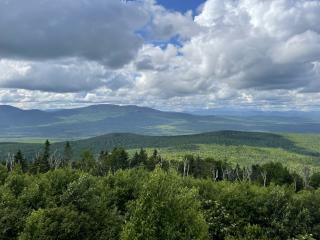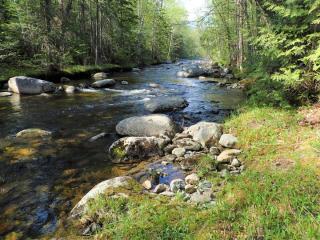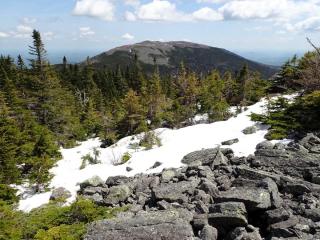Forest Legacy Program Investments Highlight Importance of Working Forests
June 29, 2023

Looking out from atop Quill Hill. USDA Forest Service photo by Lindsey Lewis
At an event in Rangeley, Maine, the U.S. Department of Agriculture’s Forest Service announced funding through the Forest Legacy Program to conserve more than 245,000 acres of the most economically and ecologically significant forestlands across the nation, keeping forestlands critical to the fabric of local economies as intact working forests. Investments from the Land and Water Conservation Fund and the Inflation Reduction Act have made the conservation of these forests possible.
The Forest Legacy Program identifies important forestlands threatened by conversion to non-forest use and works with state agencies and private landowners to conserve them as forests in perpetuity. The program is implemented through grants to states, which work with landowners to strategically conserve working forests through conservation easements or fee simple acquisitions.
One such project, the Quill Hill to Perham Stream project in Rangeley, Maine was funded in 2022 and will conserve 13,606 acres of vital forestlands for multiple uses. The state of Maine’s Bureau of Parks and Lands and partners completed the project to permanently conserve two key properties using funding from the USDA Forest Service Forest Legacy Program. The Bureau of Parks and Lands worked closely with the Forest Service, Trust for Public Land, The Nature Conservancy and U.S. Department of the Navy to secure protections for both properties that help meet shared open space conservation objectives.

A look at Perham Stream. The Perham Stream watershed is designated as critical habitat for the federally endangered Atlantic salmon. Photo courtesy The Nature Conservancy by Mark Berry.
“This collaborative project contains all the key elements that reflect Maine’s vision for conservation: a privately owned working forest that supports Maine’s timber economy, ecological reserves that sustain biodiversity, and multiple-use public land that will benefit people and wildlife for generations to come,” said Maine Bureau of Parks and Lands Director Andy Cutko.
The completion of the Quill Hill to Perham Stream project also marks an important milestone for the Forest Legacy program: more than 3 million acres of forestland conserved in the program’s 33-year history, 750 thousand acres of which are in Maine. The project will contribute to a nearly 100,000-acre landscape of connected, conserved lands adjacent to the Appalachian National Scenic Trail, and directly benefits Maine’s sustainable forest products economy, which provides an estimated 20% of employment in Franklin County. This project is a shining example of the work needed to continue to provide critical habitat for wildlife, support outdoor recreation, provide families with food and other resources, protect clean water, and are vital to local forest products economies.
With the most recent announcement, the Forest Service is providing $188 million to 34 projects located in 23 states. The 34 projects selected for funding were chosen through a competitive process that evaluated projects based on economic and ecological importance, threat of conversion, and contribution of the proposed acquisition to strategic landscape conservation efforts. These projects help to support our goal of conserving at least 30% of our nation’s lands and waters by 2030 and supports the Justice40 initiative, which guarantees that at least 40% of federal funding will benefit disadvantaged communities.

Newly conserved tracts of land are visible from Mount Abraham in the Western Maine mountains. Photo courtesy The Nature Conservancy by Mark Berry.
“Forests are a part of the social and economic fabric of local economies and provide benefit that sustain life and ways of life,” said Claire Harper, national manager for the Forest Legacy Program. “Conserving forested areas and keeping them intact ensures public access for recreators, sequesters carbon, improves local economies, and maintains key wildlife habitat for species. While these benefits are sometimes difficult to quantify, we all know it when we see it. These investments clearly illustrate the importance of keeping forests intact.”